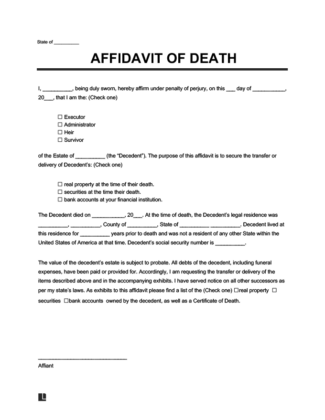
Use our affidavit of death form to verify the death of a family member and help with the inheritance process.

Updated September 26, 2023
Written by Josh Sainsbury | Reviewed by Brooke Davis
An affidavit of death notifies financial institutions, courts, businesses, and other organizations of someone’s passing. The document helps close accounts, receive benefits, or take ownership of property, real estate, or securities. It is written and signed by someone with first-hand knowledge of the person’s death and accompanied by a certified copy of a death certificate.
Without an affidavit of death, many businesses, agencies, people, and courts will not allow you to act on behalf of the deceased. Failing to use one could stop you from:
After someone passes away, their legal affairs and the estate must be handled. People need an affidavit of death for a variety of circumstances involving the efficient transfer and distribution of property, including:
An affidavit of death is for everyone’s protection. Requiring one reduces the likelihood of fraud in a court or business. It also speeds up property transfer and distribution, easing the wind up of legal affairs and one’s estate.
Affidavits of death include the following essential elements:
The most common situations for using an affidavit of death involve transferring property from the decedent to their heirs through various means.
When to use: If the deceased property owner held a title as Joint Tenants.
Most often, couples hold their homes in “joint tenancy.” This means that when one spouse dies, the other spouse becomes the sole owner of the property. An Affidavit of Death of a joint tenant allows the surviving spouse to file a notice with the title company and the county property assessor.
The title is then changed only to reflect ownership of the surviving spouse. Affidavits of death of joint tenancy are essential because the home cannot be transferred without the consent of all title owners.
When to use: If the deceased property owner held a title in a Living Trust.
A married couple is considered co-trustors when they have established a living trust. In the event of the death of one spouse, the property in the trust passes to the surviving trustor, and the surviving trustor becomes the sole owner of the property.
If no co-trustor is identified, such as when a single person has a living trust, the property will pass to a successor trustee.
The successor trustee is responsible for disbursing the property in the trust to the designated beneficiaries once the property owner dies. An Affidavit of Death of the trustee establishes the trustee’s death and helps transfer property to the rightful beneficiaries.
When to use: I f the deceased property owner held title as Community Property with the Right of Survivorship
An Affidavit of Death of a spouse allows the surviving spouse to remove the deceased spouse’s name from joint credit cards, bank accounts, money market accounts, etc.
This affidavit also permits the transfer of funds from an account solely held by the deceased to a lawful spouse (barring a will or transfer on death instruction leaving the account’s contents to someone else).
When to use: If the deceased property owner filed a beneficiary deed (or transfer on death deed).
Some states allow for “transfer on death.” For example, a person may have a checking account or savings account in their name only. Some state laws allow an account holder to designate someone as the person who receives the money in the account upon their death.
This is called a transfer of death provision. In this situation, an affidavit of death of the grantor transfers the property to the designated individual.
When to use: If the deceased property owner passes away without making a valid will or leaving specific instructions for distributing their assets upon death.
Each state has “intestacy” laws that designate how property will be distributed based on kinship. In most states, if a single person with no children dies, their property will go to their parents. If both are alive, it will be divided between a single surviving parent and siblings, or just siblings if both parents are dead.
An affidavit of death intestate permits the lawful transfer of property (such as a motor vehicle) to a rightful heir, who identifies as the legal successor based on state intestacy laws. Several states offer slightly different documents to transfer vehicle titles when someone dies without a will.
The first step in filling in an affidavit of death is to provide your information as the affiant. You should fill in your name and role in the estate. You can be either of the following:
The next step is providing information about the deceased person. You need to be able to provide the following:
Specify why you’re writing the affidavit. Typically, an affidavit of death is created to secure the transfer or delivery of the decedent’s:
Remember to attach a list of the estate you claim and the certificate of death as exhibits when filling this section.
The last section consists of filing in the governing law of the affidavit and the date the document has been created. In a dispute, the court will follow the laws of the governing state to decide.
The affidavit of death must be signed in front of a notary. Having the affidavit notarized will help verify its authenticity should there be a dispute down the line.
To start writing your affidavit of death, download one of our free templates below in PDF and Word or use our document builder to create a custom form.